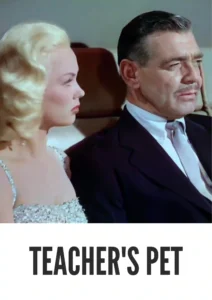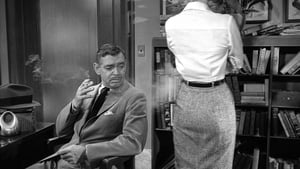Video Sources 0 Views

Synopsis

Step into the world of 1950s romance and comedy with Teacher’s Pet, a delightful film from 1958, now beautifully colorized for a fresh, engaging viewing experience. Starring the iconic duo of Clark Gable and Doris Day, this movie presents a charming story about a seasoned news editor who unexpectedly finds himself attending night classes taught by a dedicated journalism instructor. Perfect for fans of classic romantic comedies and those looking for a light-hearted, witty film, this HD download brings a touch of Hollywood glamour to your screen.
Teacher’s Pet centers around James Gannon (Clark Gable), a gruff and cynical newspaper editor who believes practical experience trumps formal education. When he receives an invitation to speak to a journalism class taught by Erica Stone (Doris Day), he initially scoffs at the idea. However, intrigued by Erica’s passion and dedication, Jim decides to attend her class undercover, posing as a student named “James Gallangher” to learn more about her teaching methods and, perhaps, to challenge her idealistic views.
As Jim spends more time in Erica’s class, he finds himself increasingly drawn to her intelligence, enthusiasm, and genuine care for her students. He begins to question his own long-held beliefs about journalism and education. Meanwhile, Erica is charmed by the eager and attentive “James Gallangher,” unaware of his true identity. Their interactions lead to a series of humorous and heartwarming moments as Jim struggles to reconcile his professional persona with his growing affection for Erica. The situation becomes even more complicated when a handsome psychologist, Dr. Pine, enters the picture, vying for Erica’s attention. The film culminates in a delightful resolution where Jim must reveal his true identity and win Erica’s heart, proving that even the most hardened cynic can learn a thing or two about love and life.
The film features a stellar cast of actors who bring this romantic comedy to life:
-
Clark Gable as James Gannon/James Gallangher
-
Doris Day as Erica Stone
-
Gig Young as Dr. Pine
-
Mamie Van Doren as Peggy DeFore
-
শিক্ষার স্বীকৃতি Oscar মনোনয়ন
Teacher’s Pet falls into the genre of romantic comedy, with elements of satire and wit that are characteristic of 1950s Hollywood. Its charming story, combined with the star power of Clark Gable and Doris Day, makes it a delightful and entertaining film.
Released in 1958, Teacher’s Pet represents a high point in Hollywood’s Golden Age of romantic comedies, showcasing the era’s signature blend of wit, glamour, and heartwarming storytelling. The film was produced during a time when audiences sought escapism and light-hearted entertainment, and Teacher’s Pet delivered on both fronts. It reflects the social attitudes and cultural values of the 1950s, particularly in its portrayal of gender roles and professional aspirations. While Teacher’s Pet may not be as groundbreaking as some of the era’s more experimental films, it remains a beloved example of classic Hollywood filmmaking.
This colorized version of Teacher’s Pet has been carefully restored using modern digital techniques, enhancing the visual appeal while preserving the film’s original charm and wit. The colorization process involved meticulously analyzing the grayscale tones of the original black and white footage and assigning appropriate colors to each scene. This painstaking process brings new life to the characters and settings, making the story even more engaging for modern audiences. While some may debate the merits of colorizing classic films, it introduces these films to a broader audience, ensuring their legacy for future generations.
-
: George Seaton
-
: George Seaton
-
: Max Schulman
-
: Haskell B. Boggs
-
: Alma Macrorie
-
: Perlberg-Seaton Productions
-
: Paramount Pictures
-
: 120 minutes
-
: MP4
-
: HD (1080p)
-
: Compatible with most devices, including smartphones, tablets, computers, and smart TVs.
Teacher’s Pet (1958) was well-received upon its release, praised for its witty script, charming performances, and delightful blend of romance and comedy. Clark Gable and Doris Day’s on-screen chemistry was a particular highlight, and the film earned several award nominations, including an Oscar nomination for Gig Young’s performance as Dr. Pine. While it may not be considered a groundbreaking film, Teacher’s Pet remains a beloved example of classic Hollywood romantic comedy, offering a delightful escape into a world of wit, glamour, and heartwarming romance. As a classic romantic comedy, Teacher’s Pet provides a unique perspective on the Golden Age of Hollywood.
-
: What is Teacher’s Pet about?
-
A: Teacher’s Pet is a romantic comedy about a cynical newspaper editor who falls for a charming journalism teacher while attending her class undercover.
-
-
: Is Teacher’s Pet (1958) a well-known film?
-
A: Teacher’s Pet is a beloved example of classic Hollywood romantic comedy, known for its witty script and charming performances.
-
-
: Is this version of Teacher’s Pet colorized?
-
A: Yes, this version has been professionally colorized to enhance the viewing experience.
-
-
: What makes Teacher’s Pet interesting for classic film fans?
-
A: Teacher’s Pet offers a delightful glimpse into the Golden Age of Hollywood, showcasing the era’s signature blend of wit, glamour, and heartwarming storytelling.
-
-
: What is the download format?
-
A: The download format is MP4, which is compatible with most devices.
-
-
: What resolution is the download?
-
A: The resolution is HD (1080p), providing a high-quality viewing experience.
-
Watch Teacher’s Pet Today!













